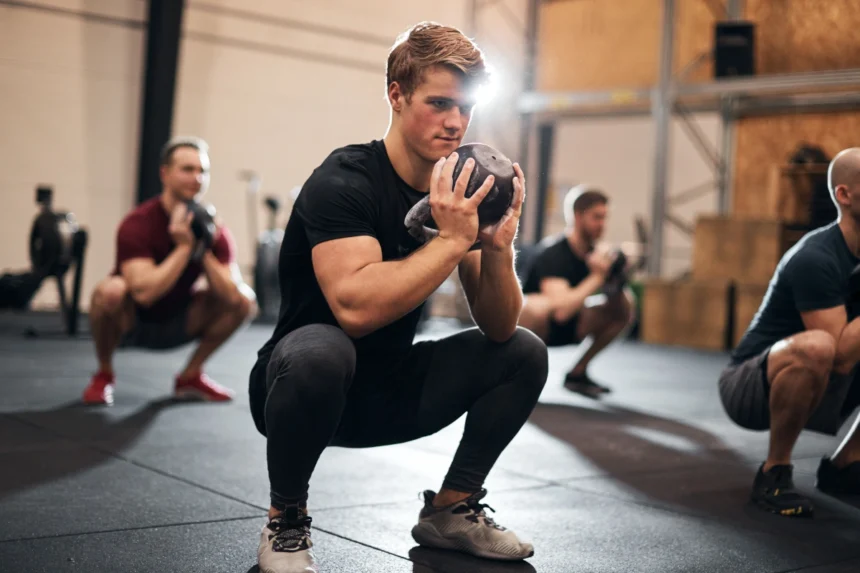The squat is a foundational movement in many fitness routines, but achieving proper squat depth requires adequate ankle mobility. To maintain balance during the squat, your knees need to travel forward beyond your toes. When ankle mobility is restricted, however, this becomes a challenge, causing compensations that can lead to improper form and potential injury.
A common problem many people face during squats is restricted ankle dorsiflexion (the ability to move the top of the foot upward toward the shin). If this range of motion is limited, you might find yourself tipping backward at the bottom of your squat. This puts your body out of alignment, and your instinct will be to lean forward to prevent yourself from falling.
This forward lean may seem like a quick fix, but it places additional strain on your lower back, which isn’t ideal. This compensation could lead to discomfort or even injury over time.
So, what can you do to improve your squat while dealing with ankle mobility issues?
Step 1: Testing Ankle & Tibia Mobility
If you’re having trouble squatting deeply, it might be because your ankles or shins are tight. These areas can cause squat problems, but testing them can help you know where to focus.
Here’s a simple way to check your ankle and shinbone (tibia) mobility to improve your squat.
Check Ankle Mobility
Ankle flexibility is important for a deep squat. If your ankles can’t bend enough, it makes squatting lower harder.
- Feet Together Squat Test: Stand with your feet close together, facing forward. Squat down as low as you can. If your heels lift off the ground or you feel tightness in your ankles, your ankle mobility might be limited.
- Elevated Heel Squat Test: To test further, try squatting with your heels raised on a small surface like a mat. If this makes it easier to squat deeper, your ankles need more flexibility.
Foot & Ankle Position Check
Next, check if your feet and ankles are in the right position during squats. Your knee should be able to move over your toes without lifting your heel.
- Toe-to-Heel Lunge Test: Stand with one foot’s toe touching the other foot’s heel. Keep both feet straight.
- Knee Over Toes Test: Bend your front knee and move it over your toes. Keep your heel flat on the ground. If your heel lifts or you feel tightness, your ankle mobility could be limited.
- Check for Imbalances: Do this on both legs. If one side feels tighter or your knee can’t move as far forward, one ankle might have less mobility.
Test Shinbone Rotation
The way your shinbone (tibia) rotates also affects your squat. Your tibia needs to rotate inward for a deep squat. If it can’t, it can limit how low you go.
- Seated Tibial Rotation Test: Sit with your knees bent and feet under your knees. Keep your thighs still and rotate your feet outward and inward. You should be able to rotate your feet about 40 degrees outward and 20 degrees inward. If you can’t, your shinbone rotation might be limited, which can make squatting difficult.
Do this on both legs and check if one side moves easier than the other. If there’s a difference, one shinbone might be less mobile.
Step 2: Exercises to Improve Ankle Mobility for Squats
Once you’ve assessed your ankle mobility, it’s time to start improving it. Here are some effective exercises that target ankle and tibial mobility to help you squat better.
1. Knee-to-Wall Stretch (Ankle Dorsiflexion Stretch)
This stretch specifically targets dorsiflexion of the ankle, which is the ability to move your foot upwards toward your shin—critical for proper squat depth.
How to do it:
- Stand facing a wall with one foot a few inches away from the wall and the other foot slightly behind.
- Keep your heel down and bend your front knee, attempting to push it forward toward the wall without letting your heel come off the floor.
- Gradually aim to get your knee past your toes while maintaining a flat foot.
- Hold the position for 20–30 seconds and repeat 2–3 times per side.
This exercise stretches the calf muscles and the tissues surrounding the ankle, helping to improve your range of motion in dorsiflexion. This is essential for deep squatting, where the knee must travel forward without the heel lifting.
2. Elevated Heel Squats (Temporary Fix for Limited Ankle Mobility)
If you struggle with ankle dorsiflexion, elevating the heels can provide a temporary solution that allows you to perform a deeper squat.
How to do it:
- Place small plates, weightlifting shoes with an elevated heel, or a wedge under your heels.
- Perform a squat as usual, allowing your knees to track over your toes.
- The elevation will reduce the demand for ankle dorsiflexion and enable you to squat deeper, as it compensates for the lack of ankle mobility.
- Use this variation while continuing to work on ankle flexibility and mobility.
By elevating the heels, you reduce the need for significant dorsiflexion, allowing you to achieve a deeper squat without your heels coming off the floor. This modification is a useful tool while you focus on building ankle mobility.
3. Tibial Internal Rotation (Tibial CARs)
Improving tibial (shin bone) rotation is key to unlocking ankle mobility and enhancing your squat depth. Tibial internal rotation helps the shin bone rotate properly as your foot stays grounded, which is important for both ankle mobility and proper squat mechanics.
How to do it:
- Sit on the floor with your knees bent at 90 degrees and your heels directly under your knees.
- Keep your thighs still and rotate both feet outward (external rotation) as far as you can, then rotate them inward (internal rotation).
- Perform 5–10 repetitions of this movement, ensuring that your feet rotate as far as possible both inward and outward without your thighs moving.
- Aim for 40 degrees of external rotation and 20 degrees of internal rotation for each leg.
Tibial rotation is essential for proper foot and ankle mechanics during squatting. This exercise improves the mobility of the shin bone, which is crucial for allowing proper foot pronation and achieving a deeper squat. The tibial internal rotation, in particular, helps facilitate ankle dorsiflexion.
4. Ankle Rockers (Ankle Mobilization)
This exercise improves both ankle dorsiflexion and the overall mobility of the ankle joint, making it easier to squat deeper while maintaining proper form.
How to do it:
- Start in a deep lunge position with one foot forward and the other leg straight.
- Keep your back leg straight and slowly rock your hips forward, driving your knee over your toes.
- Ensure your heel stays grounded as you rock forward.
- Perform 10–15 repetitions per leg, focusing on slowly increasing your range of motion.
The ankle rocker mobilizes the ankle joint, helping to improve dorsiflexion and calf flexibility. The movement mimics the squatting motion and is a great way to prepare your ankles for deep squats by promoting proper ankle movement.
5. Heel-to-Toe Walking (Foot and Ankle Mobility Drill)
This exercise encourages the natural mobility of your foot and ankle, focusing on controlled dorsiflexion and strengthening the muscles around the ankle joint.
How to do it:
- Walk in a straight line, intentionally rolling through the foot from heel to toe with each step.
- As you walk, focus on activating your calves and engaging the muscles in your feet.
- Perform 20–30 steps, ensuring that you emphasize a slow and controlled movement, particularly during the dorsiflexion phase (lifting your foot upward as you step).
- Repeat this movement for 2–3 sets.
This functional movement helps improve ankle mobility and coordination, making it easier to execute deep squats. It also strengthens the foot and ankle muscles, which will help support better form during your squats.
Step 3: Refining Your Squat Technique
After working on your ankle mobility, it’s time to test your squat again. With better ankle mobility, your knees should move more freely over your toes, and you should be able to squat deeper without leaning too far forward.
If you’re still struggling to squat deeply, try these techniques:
- Use Heel Elevation (Temporarily)
If you’re still having trouble squatting deeply, raising your heels can help temporarily. By using weight plates, wedges, or a mat, you can make it easier to squat without putting too much strain on your ankles. This allows your knees to move forward more freely and helps you squat deeper.
How to Use Heel Elevation:
- Place weight plates, a wedge, or a weightlifting shoe with a raised heel under your feet.
- Squat as usual, focusing on keeping your chest up and knees tracking over your toes.
- Pay attention to how your squat feels. You should feel more balanced and able to squat deeper without your heels lifting or leaning forward too much.
Elevating your heels changes the angle of the squat and reduces the need for ankle flexibility. While it’s not a permanent fix, it allows you to keep improving your squat while working on your ankle mobility.
- Adjust Your Stance
Changing your stance can also help you squat deeper. If your ankle mobility is limited, try squatting with a wider stance or rotating your feet slightly outward. This allows for more hip and ankle movement and reduces stress on your lower back.
How to Adjust Your Stance:
- Start with your feet shoulder-width apart.
- Gradually widen your stance until your feet are slightly wider than shoulder-width, with your toes pointing outward.
- Perform your squat, making sure your knees track over your toes and your heels stay flat.
Widening your stance and rotating your feet outward lets you engage your hips more, making it easier to squat deeply without overloading your ankles. This modification helps you squat to a depth that works with your current mobility.
- Maintain a Neutral Spine
Even with better ankle mobility, it’s important to keep a neutral spine while squatting. This helps with balance and prevents too much stress on your lower back. Avoid rounding your back or leaning forward too much, as this can reduce the effectiveness of the squat and increase the risk of injury.
How to Maintain a Neutral Spine:
- Keep your chest lifted and your shoulders back.
- Engage your core muscles to support your spine and avoid rounding or arching.
- As you squat, keep your head in line with your spine and avoid looking up or down too much.
A neutral spine helps distribute the load evenly and ensures you’re using the right muscles, especially your glutes and hamstrings. This not only makes the squat more effective but also reduces the chance of injury.
Caveat: Don’t Sacrifice Form for Depth
While it might be tempting to push yourself to perform the “ideal” squat—where your thighs are parallel to the ground or lower—it’s important not to force this range of motion, especially if you haven’t developed the necessary ankle mobility. Pushing yourself too hard can lead to compensations that increase the risk of injury.
As a trainer or someone working on their squat, the key is to adapt the exercise to your current abilities. Start by focusing on your range of motion and work within your limitations. Gradually build flexibility through targeted exercises, and over time, you’ll notice your squat improving without the need for excessive external assistance.






